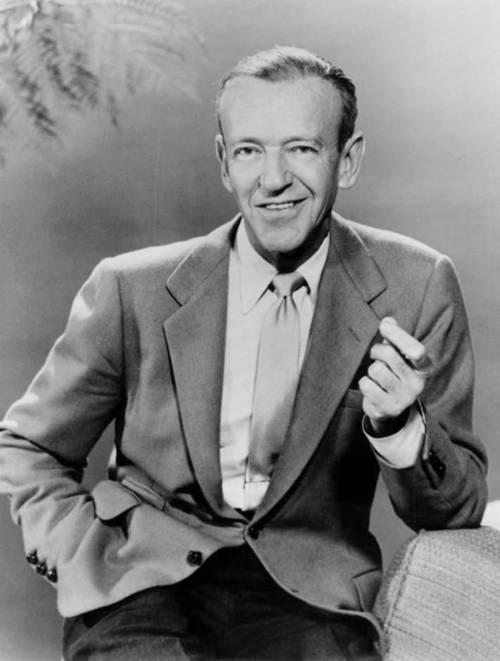
FAQ About Fred Astaire

Who was Fred Astaire?
Fred Astaire was a renowned American dancer, singer, and actor, highly acclaimed for his exceptional talent in film and stage musicals. Born on May 10, 1899, Astaire became a key figure in the history of dance due to his innovative choreography, effortless style, and charismatic screen presence. His career spanned several decades, during which he worked with many leading ladies including Ginger Rogers, with whom he formed one of Hollywood's most iconic dance duos.

What made Fred Astaire's dance style unique?
Fred Astaire's dance style was unique for its elegance, grace, and seamless integration of dance with the narrative of a film or stage performance. He was known for his musicality, technical precision, and inventive choreography that combined elements of tap, ballroom, and ballet. Astaire's performances often featured a blend of improvisation and meticulously planned routines, which gave them a distinctly spontaneous feel.

With whom did Fred Astaire frequently collaborate?
Fred Astaire frequently collaborated with Ginger Rogers, forming one of the most famous dancing duos in Hollywood history. Together, they appeared in ten films, captivating audiences with their chemistry and innovative dance routines. Besides Rogers, Astaire also worked with other notable performers like Cyd Charisse, Judy Garland, and Rita Hayworth.

Which are some of Fred Astaire's most famous films?
Fred Astaire starred in numerous classic films, with some of his most famous being "Top Hat" (1935), "Swing Time" (1936), and "Easter Parade" (1948). These films are celebrated for their outstanding dance sequences and musical numbers, which highlight Astaire's talents as both a dancer and a performer.

What awards did Fred Astaire receive during his career?
Fred Astaire received several prestigious awards throughout his career, reflecting his significant contributions to the entertainment industry. He received an honorary Academy Award in 1950 for his unique artistry in musical films, and in 1981, he was presented with the American Film Institute's Lifetime Achievement Award. Astaire also won an Emmy for his television work and a Golden Globe nomination for his supporting role in "The Towering Inferno" (1974).

How did Fred Astaire influence musical films?
Fred Astaire significantly influenced the musical film genre by revolutionizing the way dance was used in cinema. He insisted on full-body shots in dance sequences to showcase the dancer's movements completely and integrated dance as an essential part of storytelling. His innovative choreography and collaboration with choreographers like Hermes Pan set new standards in dance that influenced countless performers and filmmakers.

What was Fred Astaire's early life like?
Fred Astaire was born Frederick Austerlitz on May 10, 1899, in Omaha, Nebraska. He was introduced to dance and performing early in life, joining a vaudeville act with his older sister, Adele. They toured the vaudeville circuit as a successful brother-sister act for several years before making their way to Broadway, laying the groundwork for Astaire's future solo success in Hollywood.

Did Fred Astaire have children?
Yes, Fred Astaire had two children. He married socialite Phyllis Potter in 1933, with whom he had two children: Fred Jr., born in 1936, and Ava, born in 1942. Both children remained out of the public eye for the most part, though Fred Jr. did follow his father into the entertainment industry to some extent.

What was Fred Astaire's relationship with Ginger Rogers?
Fred Astaire and Ginger Rogers developed a professional relationship that led to one of the most celebrated dance partnerships in film history. Despite rumors of a romantic involvement, their relationship was largely professional. They shared a mutual respect and chemistry on-screen, which translated into ten successful films. Off-screen, their relationship was amicable, though not without occasional disagreements typical of creative partnerships.

How did Fred Astaire change the choreography of Hollywood musicals?
Fred Astaire revolutionized Hollywood musical choreography with his insistence on integrating dance seamlessly with narrative. By requesting full-body shots, he changed how dance was filmed, allowing audiences to appreciate the choreography fully. Astaire's innovative routines and collaboration with top choreographers set a high standard for precision, creativity, and storytelling through dance in film.

Did Fred Astaire have any other notable talents besides dancing?
Besides being a masterful dancer, Fred Astaire was also a talented singer, actor, and choreographer. He had a pleasant, light baritone voice that was well-suited to the musical films in which he starred, often performing songs that became popular hits. As an actor, Astaire was known for his charm and grace, bringing a unique presence to his film roles.

When did Fred Astaire pass away, and what was his legacy?
Fred Astaire passed away on June 22, 1987, in Los Angeles, California. His legacy endures as one of the most influential figures in the history of dance and entertainment. Astaire's work has inspired countless dancers and filmmakers, and his films continue to be celebrated for their artistry and innovation. His influence persists in the standards he set for choreography and musical performance in film.

What are some common misconceptions about Fred Astaire?
One common misconception about Fred Astaire is that his effortless dance style was achieved without practice. In reality, Astaire was known for his rigorous rehearsal processes and dedication to perfection. Another misconception is that he was a solo performer; in fact, he frequently collaborated with talented partners and choreographers who helped bring his vision to life.

Did Fred Astaire serve in the military?
Fred Astaire did not serve in the military during World War II, primarily because of his age; by the time the U.S. entered the war, Astaire was already in his early 40s and established in his career. However, he did contribute to the war effort by performing in USO shows and participating in fund-raising events for the troops.

What was Fred Astaire's impact on later generations of performers?
Fred Astaire's impact on later generations of performers is immense. His precise, innovative choreography and charismatic performances inspired countless dancers and actors. Contemporary performers across various entertainment fields cite him as an influence, admiring his dedication to craft, versatility, and ability to adapt to different music and dance styles.

How did Fred Astaire prepare for his dance routines?
Fred Astaire was known for his meticulous preparation for dance routines. He approached each new piece with detailed planning and extensive rehearsals. Astaire believed in perfecting every aspect of the performance, often practicing for weeks to achieve the seamless, effortless style that became his trademark. His commitment to practice was integral to his success and consistent performance quality.

What was Fred Astaire's relationship with choreographer Hermes Pan?
Fred Astaire and Hermes Pan had a highly successful and collaborative working relationship. Pan was a talented choreographer who worked with Astaire on numerous films, helping to create some of the most memorable dance sequences in cinematic history. Their partnership was based on mutual respect and a shared vision for the future of dance in film, which allowed them to innovate and push creative boundaries.

Did Fred Astaire play musical instruments?
Fred Astaire was not known for playing musical instruments professionally, although he had a good sense of rhythm and timing, which was evident in his dance and singing performances. His primary talents lay in dancing, singing, and acting, where he excelled and earned international acclaim.

How did critics view Fred Astaire's work?
Critics widely acclaimed Fred Astaire's work, praising his innovative approach to dance and his contributions to musical cinema. He was often regarded as a genius in his craft, setting high standards in choreography and performance. Astaire's ability to convey emotion and narrative through dance earned him a lasting reputation as one of the greatest performers in film history.

What were Fred Astaire's contributions to television?
Fred Astaire made notable contributions to television, especially during the later stages of his career. He appeared in several television specials, which showcased not only his dance skills but also his versatility as a performer. Astaire's work on television earned him several Emmy Awards, further solidifying his status as a pioneering figure in entertainment.
